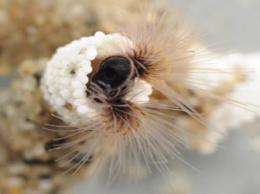Podcast: Tiny sea creature and a new medical adhesive

Scientists questing after a long-sought new medical adhesive describe copying the natural glue secreted by a tiny sea creature called the sandcastle worm in the latest episode in the American Chemical Society's podcast series, "Global Challenges/Chemistry Solutions."
Such an adhesive is needed to repair bones shattered in battlefield injuries, car crashes and other accidents.
The traditional method of repairing shattered bones involves use of mechanical fasteners like pins and metal screws to support the bone during healing. But achieving and maintaining alignment of small bone fragments using screws and wires is challenging, according to researchers, who presented their study results at the ACS' 238th National Meeting in Washington, D.C.
You probably know people who have broken bones and had screws or pins inserted in their bodies to repair the fractures. These treatments have been used for years to help bones heal. But they are far from perfect in repairing certain kinds of fractures.
For more precise reconstruction of compound fractures and shattered bones, a team of bioengineers have looked to Mother Nature for an alternative to metal hardware. Russell Stewart and colleagues of the University of Utah have duplicated a natural glue secreted by a tiny sea creature called the sandcastle worm. The hope is to fix small bones broken in battlefield injuries, car crashes and other accidents.
Here is Dr. Stewart explaining how the sandcastle worm uses the glue to construct its underwater home: “In the wild they glue together sand grains, sea shells and whatever sort of mineral particles they can get a hold of. They use these tentacles to gather those particles, and they bring them in towards their mouth. If they like the size and the texture and the shape, they’ll put a couple of little tiny dabs of glue on it and press it on to the end of the tube… Our interest is in studying that natural adhesive and understanding what it’s made out of, how it works and then copying that with synthetic polymers that we hope to use as medical adhesives.”
Still the adhesive has passed initial toxicity studies in cell cultures, and its strength exceeds that of Super Glue. For a more colorful description of the glue’s grabbing power, here’s Dr. Stewart again: “On a 1 square centimeter bond we can hang a 40-pound bag of potatoes… It might already be adequate for repairing bones that are in non-loadbearing situations, particularly the cranial facial bones.”
Although Dr. Stewart has reached certain objectives with his adhesive, he sees additional challenges on the horizon. “I think the biggest problems are still ahead of us in being able to use this in medicine because of biocompatibility issues, and we want it to degrade, and we need to tune the degradation rates. We’d like for them to be the same roughly as the natural healing process. I think those are going to be bigger problems than we’ve faced so far.”
Global Challenges/Chemistry Solutions is a series of podcasts describing some of the 21st Century's most daunting problems, and how cutting-edge research in chemistry matters in the quest for solutions.
More information: The podcast is available without charge at iTunes and from ACS at www.acs.org/globalchallenges.
Source: American Chemical Society (news : web)

















